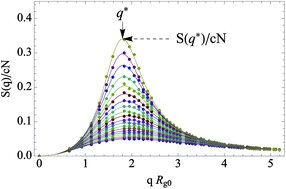Test of a scaling hypothesis for the structure factor of disordered diblock copolymer melts
Abstract
Coarse-grained theories of dense ![[N with combining macron]](https://www.rsc.org/images/entities/i_char_004e_0304.gif) , where χ is an effective interaction parameter, N is the degree of
, where χ is an effective interaction parameter, N is the degree of ![[N with combining macron]](https://www.rsc.org/images/entities/i_char_004e_0304.gif) is a measure of overlap. We test whether simulation results for the structure factor S(q) obtained from several different simulation models are consistent with this two-parameter scaling hypothesis. We compare results from three models: (1) a lattice Monte Carlo model, the bond-fluctuation model, (2) a bead–spring model with harsh repulsive interactions, similar to that of Kremer and Grest, and (3) a bead–spring model with very soft repulsion between beads, and strongly overlapping beads. We compare results from pairs of simulations of different models that have been designed to have matched values of
is a measure of overlap. We test whether simulation results for the structure factor S(q) obtained from several different simulation models are consistent with this two-parameter scaling hypothesis. We compare results from three models: (1) a lattice Monte Carlo model, the bond-fluctuation model, (2) a bead–spring model with harsh repulsive interactions, similar to that of Kremer and Grest, and (3) a bead–spring model with very soft repulsion between beads, and strongly overlapping beads. We compare results from pairs of simulations of different models that have been designed to have matched values of ![[N with combining macron]](https://www.rsc.org/images/entities/i_char_004e_0304.gif) , over a range of values of χN and N, and devise methods to test the scaling hypothesis without relying on any prediction for how the phenomenological interaction parameter χ depends on more microscopic parameters. The results strongly support the scaling hypothesis, even for rather short chains, confirming that it is indeed possible to give an accurate universal description of simulation models that differ in many details.
, over a range of values of χN and N, and devise methods to test the scaling hypothesis without relying on any prediction for how the phenomenological interaction parameter χ depends on more microscopic parameters. The results strongly support the scaling hypothesis, even for rather short chains, confirming that it is indeed possible to give an accurate universal description of simulation models that differ in many details.


 Please wait while we load your content...
Please wait while we load your content...